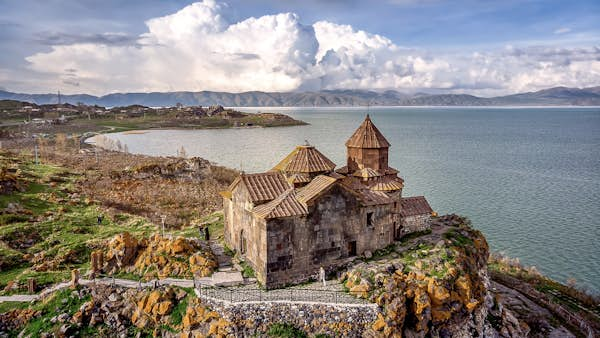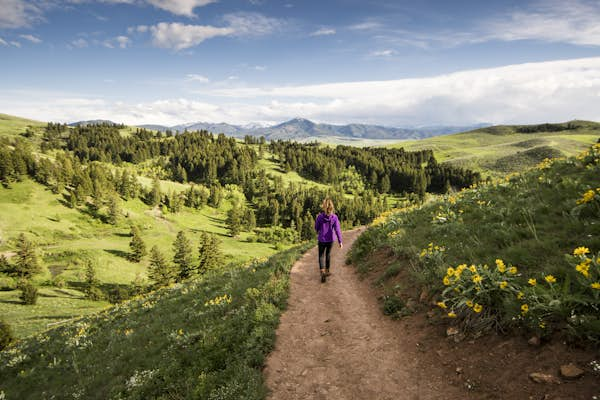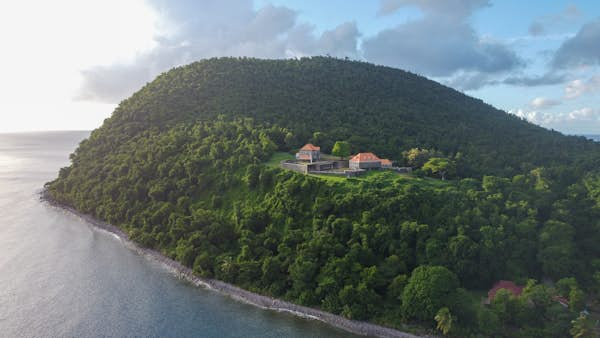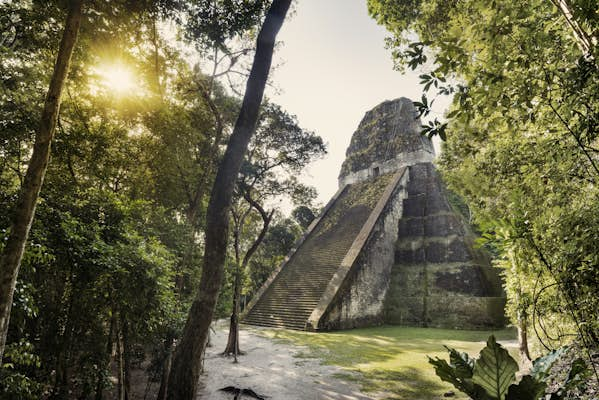


A first-time guide to Armenia
On Europe’s far eastern flank, Armenia is one of the few remaining countries on the continent where you can truly get off the beaten track. (Think: Albania five years ago.)
Rich in history and culture, this captivating country in the Caucasus is dotted with enchanting stone monasteries, many dating back more than eight centuries. Its growing capital, Yerevan, is packed from (tuff-volcanic-stone) wall to wall with galleries, performance venues and feast-worthy restaurants. And – appropriately for such a mountainous country – there’s ample hiking, too, with plenty of cozy mountain resorts and homestays to spend a few nights.
But the best part about traveling to Armenia is having the opportunity to chat with locals. Their pride and passion for their homeland is fascinating, and they might make you feel like an Armenian yourself.
Here’s everything you need to know before you visit.

When should I go to Armenia?
Armenia is hopping in summer – though it’s also very hot, with July and August temperatures in Yerevan hovering around 30°C (86°F). Summer is also time for fun festivals like Vardavar (during which locals run around tossing buckets of water at each other – and likely you), and for cooling off in Lake Sevan.
You can avoid the heat by visiting in in May or June, when it’s usually between 10°C (50°F) and 30°C (86°F) in Yerevan. Springtime is also wonderful for hiking across Armenian hilltops and valleys, which are speckled with millions of wildflowers. (Locals brew the flowers into tea or make them into jewelry.) Fall is another wise time to visit since there are fewer crowds and usually pleasant temperatures.
The long winter (November to March) isn’t ideal as many tourist amenities shut down and the temperatures can drop below freezing. If you do find yourself in Armenia at that time, stick to Yerevan, where there are plenty of ways to warm up with a glass of wine. Some great spots include In Vino wine bar and Ulikhanyan Jazz Club.
How much time should I spend in Armenia?
Many people pop over to Armenia after visiting Georgia – it’s a quick and easy trip over the land border to Armenia’s UNESCO-listed monasteries Sanahin and Haghpat. If you’re short on time, fly directly into Yerevan’s Zvartnots Airport, which has lately been welcoming more and more flights from Europe and the Middle East.
If you have time, spend a week or two circling Armenia in a car – the country is slightly smaller than Belgium, so it won’t take too much time.

Is it easy to get in and around Armenia?
Armenia is still connected by Soviet-era minibuses called marshrutky, which can be a frustrating mode of travel as they don’t have fixed schedules. Trains, which run between Yerevan and Batumi in Georgia with a few stops along the way, are extremely slow, so aren’t recommended if unless you have ample time.
The easiest option to get around Armenia is via car or van tours. You’ll find plenty of operators with reasonable prices around Republic Square in Yerevan.
Yerevan itself is very walkable, and ride-hailing apps GG and Yandex are a common and affordable way to get around (Armenia doesn’t have Uber). Yerevan also has spiffy new city buses and a one-line subway, though you won’t likely need them if you stick to exploring the city center.
If you have time, the best way to explore Armenia is by renting a car from the airport or through an agency in Yerevan. Having your own vehicle will give you the freedom to stop when you want and hike to remote monasteries. There are also a few cool campgrounds for road trippers on a budget, including Crossway Camping, where you can stay in a hippie bus, or Camping 3 Gs, which has epic views.

Top things to do in Armenia
A visit to Armenia will undoubtedly include a visit to one of its marvelous stone monasteries – after all, Armenia is the world’s first Christian nation. Some of the finest are within a couple of hours from Yerevan, including Noravank, which shines gold at sunset, and Khor Virap, where Surp Gregory the Illuminator was imprisoned before convincing King Tiridates III to declare Armenia Christian in 301. Most monasteries are located in canyons or on mountaintops; explore them on foot with the help of local hiking app HIKEArmenia.
A trip to Armenia’s cities is wonderful if you’re into art and high culture. Yerevan is filled with art galleries dedicated to notable Armenian artists like Sergei Parajanov – one of the world’s great film directors – and performance venues like the grand National Opera and Ballet Theatre. In Armenia’s second city, Gyumri, you can wander around tuff-black-stone buildings and visit the Aslamazyan Museum, which is dedicated to two artist sisters, one of whom many consider Armenia’s Frida Kahlo.
Armenia is a burgeoning wine destination and home to the world’s oldest winery, inside the Areni-1 Cave. You can sip Armenia’s unique areni grape wine among vineyards at Momik Wine Cube.
Or hit the trails. Surrounded by forested paths, Dilijan is a great mountaintop base; you can also hike up Mt Aragats, Armenia’s tallest mountain. If you’re up for a (much) bigger challenge, you can through-hike the Armenian section of the epic Transcaucasian Trail.

My favorite thing to do in Armenia
For those who lived through the Soviet days, decaying brutalist stone architecture might be considered a painful reminder of the USSR’s collapse. For me, as a Canadian, exploring abandoned Soviet structures is my favorite thing to do in Armenia.
Yerevan’s Children’s Railway still runs and is fantastic, as is the pyramid-like Cafesjian Center for the Arts (aka the Cascade), which has been reimagined as an amazing art gallery and sculpture garden. Outside the capital, check out the telescopes around Byurakan. There are sometimes tours of the Byurakan Astrophysical Observatory and – depending on the guard’s mood – you have a good shot of visiting the abandoned Radio Optical Observatory 54.

How much money do I need for Armenia?
Armenia has its own currency, the dram, easily exchanged at money changers in Yerevan or withdrawn from ATM with little or no fees. Credit cards are widely accepted in Yerevan, but not outside the capital.
While Armenia might be cheap by European standards, prices are still higher than many nearby Central Asian countries. The most expensive place is Yerevan, and there are several high-priced resort areas like Dilijan in the north, as well as along the western beaches of Lake Sevan.
If you’re on a budget, try a homestay or B&B – these allow you to connect with locals and often feature the option of learning to make Armenian dishes like gata (cake).
- Hostel room: Around 7500AMD (around US$20)
- Basic room for two: Starting at 30,000AMD ($80)
- Self-catering apartment (including Airbnb): Starting at 20,000AMD ($50)
- Public-transport ticket: 300AMD ($1)
- Soorch (Armenian coffee): 500–800AMD ($2)
- Lahmajun (Armenian flatbread): 500–1500AMD ($2–3)
- Dinner for two: Around 7500AMD ($20) and up
- Local beer at the bar: 800AMD ($2)
Is Armenia safe?
Tensions have been rumbling with neighboring Azerbaijan since the fall of the Soviet Union, leading to multiple wars and frequent fire across Armenia’s eastern border. In 2023, Azerbaijan seized the disputed territory of Nagorno-Karabakh; discussions of a permanent peace deal remain ongoing. Whether a peace deal is reached or not, Armenia is generally safe to visit, though it’s a good idea to avoid the border areas with Azerbaijan.

Can you travel between Armenia, Azerbaijan and Türkiye?
You cannot travel by land or air between Armenia and Azerbaijan directly, though you may connect through a third country like Georgia. Flights are available to and from Türkiye; the land border is only open to those who aren’t traveling on Armenian or Turkish passports.
Land borders are open with Georgia and Iran, but be sure to carefully research visa requirements if thinking about a trip to the latter.
How much English is spoken in Armenia?
Since the principal languages spoken are Armenian and Russian, fluent English is rare in Armenia, Yet don’t be discouraged. You should be fine with English in Yerevan, and Armenians are famous for making themselves understood using any means possible, including their hands.

Do I have to cover up?
Due to their Christian Orthodox faith, Armenians tend to dress more conservatively and show less skin than in Western Europe. But things are starting to change, due in large part to the influx of liberal Russians fleeing the war with Ukraine. Nevertheless, it’s still a good idea to dress respectfully, especially when entering a church.

The best hikes in Bozeman for outdoor splendor
You could spend half a lifetime exploring the forests, lakes and granite peaks of the Gallatin, Madison and Bridger ranges around Bozeman, Montana. Luckily we’ve done the heavy footwork for you – you can experience the very best Montana has to offer on these spirit-restoring hikes.
Bozeman is geared firmly towards the great outdoors, and between June and October, you’ll find yourself sharing the trails with mountain bikers, fly fishers and horse packers, as well as eager trekkers. But with so much wilderness on offer in this stunning corner of Montana, solitude and beauty are only ever just a short hike away. Here’s our pick of the best hikes around Bozeman to get you started.
The M
Best easy detour from downtown
3 miles (4.8km) round trip, 90 mins, elevation gain 850ft (259m), easy to moderate
The short uphill walk to the Montana State University “M” etched into the suburban hills north of Bozeman is easily the most popular hike in town, and a classic choice if you are tight on time. Two dog-friendly trails lead up from the trailhead – the right-hand path is steep and direct, while the left-hand path follows gentler switchbacks and is around a mile longer. Combine the two for a satisfying loop.
Forty minutes of puffing will reward you with expansive views over Bozeman and the snow-capped Gallatin Mountains beyond. If this taster leaves you wanting more, trails continue up the Bridger ridgeline to 8914ft (2717m) Baldy Mountain, for a total return hike of 9.5 miles (15.3km). On the drive back to Bozeman, stop off at Map Brewing for patio views of the M over a pint of aptly named Steep Terrain Double IPA.
A local tip: If the parking lot is full (as it often is), head across the road to the larger Drinking Horse Trailhead, where you’ll often find space.

Sacagawea Peak
Best for exhilarating ridgeline views
4.5 miles (7.2km) round trip, 3 hours, elevation gain 2100ft (640m), moderate to strenuous
Most hikers head south from Bozeman towards Yellowstone, so buck the trend by heading northeast into the less-visited Bridger range. A rough drive up Fairy Lake Rd (Forest Road #74) will drop you near the trailhead camping ground and a gorgeous turquoise lake (bookmark this for a deliciously frigid dip on your return).
The trail itself climbs from the get-go, rising through meadows of blazing paintbrush flowers and up lung-busting switchbacks to spit you out above the tree line onto a high saddle. Keep an eye open for Montana’s iconic (and somewhat comical) white-tufted mountain goats as you soak up the immense views.
The final section is a dramatic ridge walk onto the uplifted slab of 9654ft (2943m) Sacagawea Peak, the highest point in the Bridger range, named in honor of the Shoshone woman who guided Lewis and Clark through the valleys west of Bozeman.

Hyalite Creek Trail
Best for waterfalls and lakeshore views
11 miles (17.7km) round trip, 5 hours, elevation gain 2000ft (607m), moderate
To get a taste of the rugged wonders of the Gallatin Range south of Bozeman, drive past the paddleboarders at Hyalite Reservoir and make a beeline for the Hyalite Creek trailhead. Over 5 miles (8km) of gradual ascent, you’ll pass 11 – yes, 11! – waterfalls and gain great views of the glacially-carved, U-shaped valley. There’s also a decent chance of spotting elk, bears and even bighorn sheep. Arrive at dramatic Hyalite Lake in time for the perfect lakeshore picnic.
Fit hikers can continue for 2.5 miles (4km) up zigzagging switchbacks to bag 10,295ft (3138m) Hyalite Peak, scoring epic 360-degree views of Lone Mountain, the Paradise Valley and the Gallatin Crest Trail as it snakes towards Yellowstone National Park.
It’s a 20-mile (32km) drive back to Bozeman for dinner, but you could always pack some s’mores and stay in one of the three pine-scented Forestry Service campgrounds in Custer Gallatin National Forest (at Hood Creek, Langohr and Chisholm).
Lava Lake
Best Gallatin day hike
6 miles (9.7km) round trip, 3–4 hours, elevation gain 1600ft (488m), moderate
Leading south from Bozeman towards Yellowstone National Park, the beautiful Gallatin Canyon is lined with tempting side trails, the easiest and most popular of which leads to Lava Lake. The trail follows rushing Cascade Creek through pine forest and lush meadows, before popping out into a gorgeous mountain-fringed bowl, part of the protected Lee Metcalf Wilderness.
There’s exhilarating paddling and trout fishing at the lake and the valley also makes an easy overnight camping trip, though fires are banned within half a mile of the shoreline. The Lava Lake Trailhead is a 30-minute drive from Bozeman, southwest on Hwy 191, but take particular care where the trailhead road joins the fast-moving traffic on the highway.

Beehive Basin
Best for big sky views and microbrews
6.5 miles (10.5km) round trip, 3–4 hours, elevation gain 1500ft (457m), easy to moderate
Our favorite hike at Big Sky, 50 miles southwest of Bozeman, this half-day tramp climbs up through a stunning glacier-carved cirque to two alpine lakes that sublimely mirror the dramatic gneiss walls of the Spanish Peaks behind. En route, you’ll score views of pyramid-shaped Lone Mountain (itself the destination for an epic summer day hike) before winter cloaks its slopes with Montana’s best ski runs.
Pick up a gourmet picnic lunch en route to the trailhead at the Hungry Moose Deli in Big Sky, then round off a perfect Montana day with a post-hike microbrew at Big Sky’s Beehive Basin Brewery, named after this very hike.
Spanish Peaks
Best for sublime backcountry camping
15–25 miles (24–40km), 2–3 days, strenuous
If you’re looking for a classic multi-day backpacking trip, you can’t do better than the rugged and dramatic trip to Spanish Peaks, hidden deep in the Madison range southwest of Bozeman. A stunning group of mountain lakes gather at the base of 11,000ft (3350m) peaks, and the valleys come alive with mountain goats, deer, elk, bears, marmots and cute, rabbit-like pika.
There are dozens of gorgeous lakes to explore. The most popular route leads straight to the four Spanish Lakes, with a detour up a side valley to Mirror Lake. To expand the trek into a three-day/two-nighter, add on Jerome Rock Lakes and Lake Solitude. Alternatively, find your own unnamed tarn, set up camp for the night and watch the alpenglow climb the rock walls above.
The Spanish Peaks Trailhead is 30 miles (48km) from Bozeman, 8 miles (13km) up Spanish Creek Rd. En route, look for the grazing bison of the Flying D Ranch, owned by media mogul Ted Turner, founder of CNN.
Tips for hiking in Bozeman, Montana
- Stop in at the Custer Gallatin National Forest office in western Bozeman before a hike to get the latest information on trail closures, fire conditions and bear sightings.
- Montana is grizzly bear country, so carry a canister of bear spray, know how to use it and have it accessible at all times on any wilderness hike.
- Don’t worry if you don’t have all the gear – Bozeman’s outdoor gear shops sell the essentials, including bear spray, bug spray, local topo maps and hiking guidebooks.
- Four seasons come in one day in Montana’s mountains – always pack warm clothing, a dry base layer and a sun hat.
- Don’t rely on cell coverage in the mountains; tell someone where you are going and when you plan to be back in case anything goes wrong.

8 top things to do in Dominica: hikes, swims, culture and more
Dominica provides an unhurried respite for those looking to disconnect from life’s chaos.
Yet throughout the Caribbean island nation’s mountainous terrain, deep gorges, verdant foliage, endless trails and bountiful rivers also make it an adventurer’s playground.
Don’t expect sprawling luxury beach resorts and bone-white-sand beaches here. For Dominica’s secret sauce lies in its untouched, raw qualities – which is why many know it as “the nature isle.”
You should start getting excited about any visit to Dominica. To help, these are our picks for the best things to do on the island.

1. Dive at the effervescent Champagne Reef
Diving at Champagne Reef mirrors the sensation of swimming in an oversized glass of the bubbly drink thanks to volcanic gas that bubbles up from the seabed. The golden hue of the reef itself completes the effect.
Snorkeling enthusiasts will also be enamored with the burst of color reflecting from the horde of sea creatures, including trumpet fish, parrotfish, frogfish, octopus, rays, batfish, hawksbill turtles and seahorses. The vibrance of the pink azure, red rope, yellow tube and purple vase sponges adds to the kaleidoscopic effect.
Planning tip: Large pebbles dot the Champagne Reef beachfront, so don’t come expecting to lie out on the sand. But do enjoy the local rums, Dominican cuisine and intel on the best snorkeling spots at Donny’s Beach Bar.
2. Immerse yourself in Kalinago culture
The Kalinagos are the descendants of the pre-Columbian indigenous people of the Lesser Antilles who once lived solely on what nature provided. Today, approximately 3000 Kalinagos live on 3700 acres of communally held land reserved for the tribe on the eastern side of Dominica. The tribe is led by a six-member council and a chief.
Today, a series of tours exposes visitors to the enduring history, rituals and customs of the island’s first inhabitants, creating connections to the Kalinago culture. These tours also generate income for members of the community. The experiences range from half-day excursions to homestays with a family on the reserve in traditional housing: ajoupas made from wood and leaves.
Local tip: Kalinago cuisine is amazing. Try the roasted crayfish with coconut milk served on a warmed balisier (heliconia) leaf, and sip on ouicou juice extracted from grated cassava.

3. Lounge on Pointe Baptiste Beach
While Dominica’s 365 rivers are a highlight of its interior, Pointe Baptiste Beach might be the best spot to enjoy the salty sea. Drive to the village of Calibishie on the island’s northeast coast to reach this secluded haven, which offers an opportunity to unwind in peace.
The water is shallow, warm and tranquil, which makes it ideal for kids. Yet couples will still have enough privacy thanks to the surrounding stones and Red Rocks. This natural auburn-colored formation hugs the northeastern coastline and overlooks the Atlantic Ocean.
Local tip: Explore the sweeter side of Dominica at the nearby Pointe Baptiste Estate Chocolate Factory. The small family operation takes visitors through a tour of the process that transforms cacao beans into flavorful chocolate bars.

4. Hike to bubbling Boiling Lake
Dominica’s acclaimed Boiling Lake lives up to the hype. The journey to the flooded fumarole starts in Laudat, a small village tucked away in the island’s interior. Depending on your hiking skill level, it will take two to four fours before you ultimately descend upon the world’s second-largest boiling lake (at 200ft / 61m wide).
The trail seems manageable at first – but we highly advise setting out with a guide is to help navigate the occasionally rocky and muddy terrain and paper-thin ridge. At the end of the ascent, you’ll find a bubbling hot cauldron of slate grey liquid, shrouded in vapor.
Typically, for any arduous, extended journey, you’ll be pleased to know that the return trip seems much quicker.
Planning tip: Be sure to fill up your water bottle at the Breakfast River, which is the only fresh water available after the hike begins.
5. Spend a day at Trafalgar Falls
To the west of the Morne Trois Pitons National Park, Dominica’s twin falls are a mere 20-minute drive from the capital, Roseau.
A brief 10- to 15-minute walk through the rainforest leads to a viewing platform where you can embrace the majesty of the falls. Locally known as “Papa” (on the left) and “Mama” (right), each has its distinct features. Papa towers over the surroundings at 125ft (38m); Mama is more diminutive at 75ft (23ft) but has a more forceful gush of water. Consider a dip in the warm pools at the base of the falls.
A guide is necessary if you wish to hike the falls. Be extremely careful, as slippery boulders can make for a treacherous and challenging climb. Head out as early as possible for optimal lighting.
Local tip: Wildlife and rare plant lovers should consider a pit stop at Papillote Tropical Gardens, just before the trailhead.

6. Explore the streets of Roseau
Roseau is a small, compact southwestern city surrounded by Morne Bruce, the Caribbean Sea and the Roseau River. A walking tour of its significant sites will introduce you to this quaint capital.
Start with the Old Market, once a bustling trading post in colonial times. Today, it has been reimagined as a craft hub where vendors ply handmade soaps, oils, accessories and fragrant spices. The Dominica Museum shares the seafront with historical and cultural artifacts curated by the island’s foremost historian, Lennox Honychurch.
The once-thriving Dominica Botanic Gardens suffered extensive damage at the hands of Hurricane David in 1979 – but still boasts some 50 types of plant life on its 40 acres. Make the hike up Morne Bruce to soak in the stunning panoramic views of the city, then cool down later at one of the local haunts with the hometown beer Kubuli.
Planning tip: Consider purchasing a budget-friendly tourist-site pass. A week-long pass with multiple visits to all sites within the national park system and several other nature landmarks costs just US$12.

7. Experience the ethereal Emerald Pool
In Dominica, you’ll see endless shades of green, from the dense forests to the luminescent, appropriately named Emerald Pool. A gush of fresh water from a 40ft (12m) waterfall feeds this lovely grotto. Its greenish tint reflects the foliage, vines and moss-covered rocks that envelop the area, with sunlight filtering through, lending an ethereal effect.
Emerald Pool is easily reachable, with the access road leading from Pont Cassé, a small, centrally located village, through Morne Trois Pitons National Park. Hop a local minibus and let the driver know where you’re going. There’s also plenty of parking if you decide to drive yourself.
Two viewing platforms provide a magical vantage point; if you prefer to swim, bathrooms and changing rooms are also available at the visitors center. You might recognize the oasis as one of the stunning backdrops from the Pirates of the Caribbean franchise.
The water is chilly, even on the hottest days. The water is also not very deep, so don’t jump off the higher rocks or dive in.
Local tip: Venture about 15 minutes away to nearby Castle Bruce and enjoy a sumptuous meal and drinks at Islet View Restaurant & Bar, which overlooks the bay.

8. Hike parts (or all!) of the Waitukubuli National Trail
Did you really visit Dominica if you didn’t hike a portion of the Waitukubuli National Trail (WNT)? The iconic trek is 114 miles (183km), spanning the island’s entire length. From the northernmost point at Scott’s Head, it snakes through dramatic mountainous landscapes and dense rainforest to Cabrits National Park.
WNT is the only long-distance hiking trail in the Caribbean. Each of the trail’s 14 segments presents its unique challenges – so if you’re not up for the entire route, pick one or more sections to explore.
The difficulty level of the trail’s segments varies from easy, family-friendly walks to more strenuous expeditions. If you’re game to tackle the whole shebang, prepare for a serious time commitment: the entire route takes two weeks to complete. It’s always best to hire a guide or join a hiking group.
And the rewards are manifold as you meander through waterfalls, rivers, Kalinago villages, Maroon passages and multiple other historical and natural sites.
Planning tip: With 365 rivers woven throughout the island, running into one during a hike is inevitable. Proceed cautiously, as you may encounter slippery rocks or flash flooding from heavy rainfall.

The 14 best places to visit in Central America: ruins, reefs and romantic beaches
If you’ve ever dreamed of hiking a volcano, exploring ancient ruins and snorkeling across a coral reef all in one trip, then Central America is the place for you.
Its seven countries offer some of the world’s most sought-after destinations. History buffs will have a hard time choosing between Maya ruins and colonial cities.
Nature lovers can stalk monkeys and sloths on treks through the jungle or watch newly hatched turtles scramble for the sea. Surfers and beach bums will be satisfied, too – there are endless seaside dream destinations.
Whatever you choose to do, the results won’t disappoint. (You could even do the lot.) Short regional flights and an extensive bus network make it easy to visit several countries in one trip.
To narrow it down, here are the 14 best places to visit in Central America. Be warned, though: wherever it is you go, you run the risk of never wishing to leave.
1. Splash about on Ambergris Caye in Belize
Dubbed La Isla Bonita (The Beautiful Island), Belize’s most popular vacation island offers sun-drenched days, ritzy resorts and an imaginative culinary scene.
The bustling city center, San Pedro, boasts some can’t-miss nightlife, too. But travelers mainly flock here to enjoy the island’s bathtub-warm waters and flourishing undersea environment.
Whether you aim to dive off an island dock and backstroke in the surf, kayak through a mangrove lagoon or snorkel over brightly colored reefs alongside nurse sharks and small stingrays, Ambergris Caye has you covered.
2. Marvel at Guatemala’s spectacular Lago de Atitlán
Ringed by lush hillsides and towering volcanoes, Central America’s deepest lake is an unmissable scenic escape; the aquamarine waters of this endorheic crater basin lure travelers from all over the globe.
It’s also home to several diverse communities that proudly display their traditional Guatemalan ways of living.
Most travelers come here for long-distance kayaking and volcano climbing. Lively San Pedro La Laguna is great for throwing it down, too.
But Lago de Atitlán also attracts those wanting to learn Spanish, practice yoga or stay with a local family. Whatever you do, take some time to relax and reflect as the gentle waters of this glorious lake lap against the shore.

3. Get a taste of island life at Bocas del Toro in Panama
Dotted with Caribbean-style clapboard houses and awash with dockside restaurants and hotels, this stunning archipelago is Panama’s hottest ticket.
Its swaying coco palms and translucent blue water attract throngs of international travelers – some who’ve stayed forever.
During the day, you can pedal a beach cruiser around, snorkel among giant sea stars, surf reef breaks, tour chocolate farms and feast on delicious Caribbean fare. In the evenings, Latin rhythms and clinking glasses fill the air on Islas Colón.
4. Wander the forest-covered Maya city of Tikal in Guatemala
If you strolled this ground 1200 years ago, you’d be walking through a thriving Maya metropolis. Today, Guatemala’s most significant archaeological site is all haunting ruins and twisting jungle – interrupted only by the occasional cacophony of bird squawks and howling monkeys.
Tikal once rivaled Rome for size, population and political clout, but a millennium of dense overgrowth has since reclaimed the remains of this once-mighty empire.
The sprawling park merits multi-day explorations: base yourself in laid-back, lakeside Flores or stay on the site to see the sun rise over these majestic, ancient temples.

5. Get under the skin of Panama City
The glistening steel-and-glass skyline of Central America’s most hustling, bustling capital city is only its tiara. The heart and soul of the city lie in its older districts like Casco Viejo. This area brims with restored colonial buildings, many of which are now boutique hotels, swanky restaurants and countless rooftop bars.
Seek out the crumbling 16th-century ruins of Panamá Viejo – part of the original city – as well as the rollicking nightlife of Calle Uruguay. The city’s casinos also add another level of excitement.
Visitors can drive west to see the ingenious lock system of the world-famous Panama Canal. The rainforest and beach are only a coconut toss away too.
6. Drive Ruta de las Flores, El Salvador’s best road trip
For a glimpse into the soul of El Salvador, cruise the 20 miles between Sonsonate and Ahuachapan in a car. The local villages, artisanal shops, fragrant coffee plantations and colorful wildflower meadows are essentially the entire (admittedly small) country writ small.
Stop at any of the five main settlements over a weekend, and you’ll find them abuzz with food extravaganzas and merrymaking.
Leave ample opportunity to shop for crafts and gulp the coffee, regardless of when you go. Don’t be afraid to veer off the main route either: at Los Chorros de Calera, you can hike among the cliffs and dive into waterfall-fed swimming holes.
7. Fall in love at romantic Manuel Antonio in Costa Rica
Manuel Antonio is for lovers – the area’s romantic dining establishments, picturesque beaches and invigorating spa treatments define this welcoming destination.
Dozens of exquisite hotels perch on cliffs overlooking the cerulean Pacific on the Pacific coast of Costa Rica. And as a bonus, wildlife encounters are all but guaranteed. Squirrel monkeys swing by at breakfast while iguanas bask with guests by the pool, and true nature lovers can also spy on sloths at the nearby Parque Nacional Manuel Antonio.
Thrill-seeking honeymooners will also be satisfied, as all the requisite Costa Rica adventures – zip-lining, white-water rafting, kayaking and more – are just beyond your doorstep.

8. Wander in awe around Granada, Nicaragua’s oldest city
Granada is one of the oldest colonial cities in the region, and no trip across Central America is complete without exploring its well-preserved architecture.
In Parque Central, the saffron-yellow Catedral de Granada presides over the square, where food vendors and handicraft artisans hawk their goods.
Over by the lake, get into a boat or kayak for a tour of Las Isletas – a bunch of volcanic islands just off the city’s shore – where you’ll find fancy vacation homes and an old Spanish fortress.
9. Chill on the beaches of Costa Rica’s Southern Caribbean Coast
The pace on Costa Rica’s Caribbean shoreline is decidedly sloth-like, and that’s exactly why travelers can’t get enough of it. They come here to slow down, sip on fresh coconuts, lounge on graham-cracker-colored beaches and bathe in the warm blue-green water.
For those who prefer more active experiences, there are plenty of jungle hikes, cacao farm tours and snorkeling excursions to sign up for.
Wild, all-night parties are always an option, too. Just remember to fuel up first on the spectacular local cuisine: think whole fried snapper with a side of coconut rice and fried plantains, washed down with agua de sapo (unrefined sugar, limes and ginger known as “toad juice”).
10. Party the night away at Playa El Tunco in El Salvador
Named for a distinctive pig-shaped rock (tunco means pig), this black-sand paradise is famous for its beach breaks and even more famous for its hard-partying surfer crowd.
Weekend mayhem tops the agendas of locals and tourists alike, with everybody nursing their hangovers the next day with thin-crust pizza from Tunco Veloz.
Those seeking a more laid-back experience need only travel a few minutes in either direction to arrive at tranquil, secluded beaches. In the windswept wilderness of Barrio Santiago, turtles hatch along the shore.
11. Joining the backpacking crowd on Utila in Honduras
If you’ve got big travel dreams but a little budget, Utila is just the spot, particularly if you’re looking to don some flippers. The dreamy turquoise waters off this palm-dotted Caribbean island in Honduras are replete with surreal coral formations and curious fish, and diver certification courses here are some of the world’s most budget-friendly.
All year round, snorkelers and divers can shimmy around near whale sharks on the island’s northern tip. Then, when the adventures are over, some tasty seafood and a lively bar scene await.
12. Chow down on Caribbean food on Nicaragua’s Corn Islands
If you like it spicy, head for Central America’s Caribbean – in particular, these two remote islands off the eastern coast of Nicaragua. This is the region’s epicenter of spiny lobster, and plenty of locals make a living off ensnaring it.
After you’ve had your fill of the coveted crustacean, bite down on whole fried snapper, a heaping plate of rice and beans,and the famous rondon, a local soup with fish, shellfish, tubers, heart of palm, plantains, peppers and piles of spices.
On Great Corn – the larger and busier of the two islands – restaurants serve this stew year-round. The ingredients must simmer all day in a spicy coconut broth, though, so you’ll need to give 24 hours’ notice for your order.
13. Admire the ancient Mayan sculptures of Copán in Honduras
Of all the ruins scattered around Central America, Copán has the most impressive chiseled stone sculptures. Human-sized carvings punctuate this UNESCO World Heritage Site, which is tucked into a scenic river valley that as many as 20,000 people once called home.
A day spent peering around these temples and the surrounding sites offers a deep dive into the region’s past. Don’t miss the revered hieroglyphic stairway, which describes the history of the ancient city’s rulers in the longest inscription of Maya text known to man.
The neighboring town of Copán Ruinas has boutique hotels; you can also stay in the nearby pine-forested hills at Hacienda San Lucas.
14. Dive Blue Hole Natural Monument in Belize
Just as climbers have Mt Everest, scuba divers have Belize’s Blue Hole National Monument. They dive more than 100ft into this massive submarine sinkhole, cruising past oversized stalactites and sometimes encountering large, powerful reef sharks as they stare down into the 430ft abyss.
On the nearby islands of Ambergris Caye and Caye Caulker, you’ll find environmentally friendly and highly experienced tour operators.
But travelers seeking a more adventurous experience should consider a stay on Long Caye, a small and secluded island just minutes from the country’s most coveted underwater attractions.




